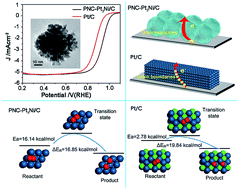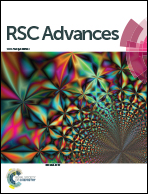Porous Pt3Ni with enhanced activity and durability towards oxygen reduction reaction†
Abstract
The size of nanocrystals (NCs) is regarded as one of the vital factors determining their electrochemical performance. To achieve high electrochemical activity and durability at the same time still remains a big challenge. This work has demonstrated the successful synthesis of Pt3Ni nanocrystals of large size with porous characteristics (PNC-Pt3Ni). The mass and specific activity of the as-prepared catalyst are 6 and 6.6 times more than those of commercial Pt/C at 0.9 volts versus the reversible hydrogen electrode (RHE), respectively. More importantly, PNC-Pt3Ni prevails against a durability test (23.7% loss of mass activity after 10 000 potential cycling) with little change to the porous morphology under harsh experimental conditions. Density functional theory calculations show a much lower activation energy for PNC-Pt3Ni during the process of dissociation of the oxygen molecule adsorbed on the surface of the catalyst, which may account for the improvement in the catalytic activity. The lower series resistance for PNC-Pt3Ni is also verified by electrochemical impedance spectroscopy (EIS) data, resulting from fewer grain boundaries for nanocrystals with large sizes. This exciting work contributes a new strategy for the optimization of electrochemical performance and durability.



 Please wait while we load your content...
Please wait while we load your content...